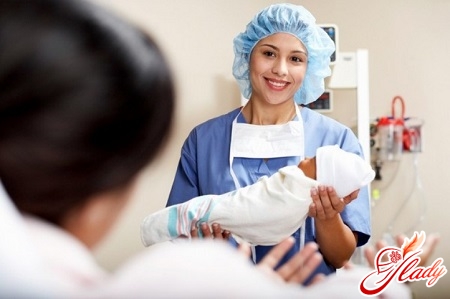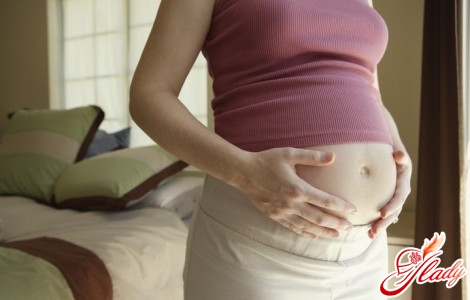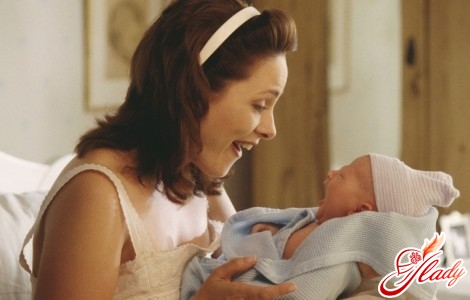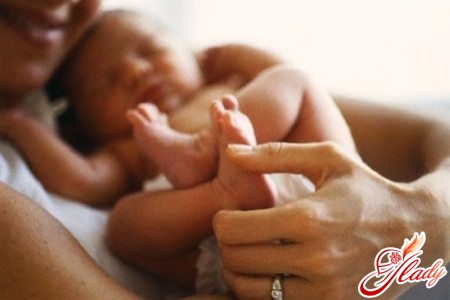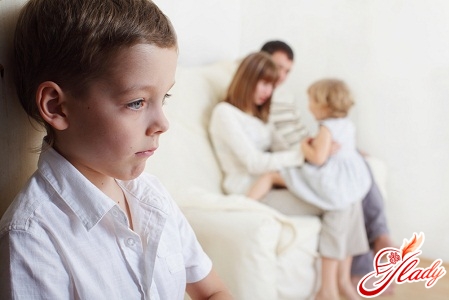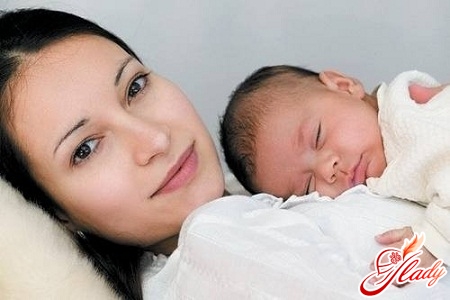 The first 6-8 weeks after the birth of a child isa period of physical and emotional adjustment. The work of the long nine months is over, you have seen your wonderful baby, a sense of spiritual recovery and blissful ease has replaced the severity of the last days. But soon the euphoria passes, and you feel tired and lightly weak. You need a good rest. After giving birth, your body undergoes rapid physical and hormonal changes. These changes are normal, but can be accompanied by fatigue, which undermines your well-being and confidence in the ability to cope with the newborn and changes in lifestyle. Your family adapts to the appearance of the baby in the house, the responsibilities of each member of the family change, all efforts are directed at satisfying his needs. Help of close relatives or friends during this period is especially necessary. The relationship in each family is unique and unique in its kind. Some families find a comfortable balance within a few weeks after the birth of the child, others need months and a longer time. Family life experiences are affected by many factors, including the nature of the child, medical complications in the mother or child, the amount of care provided, economic resources, experience in feeding and caring for the child, as well as the current situation: do parents depend only on themselves or can help close lonely motherhood, mixed family and, finally, the ability to adapt, the pliability of parents. If you understand the main problems associated with the postpartum period, then you can evaluate and load in the future and plan to receive the assistance that you will need.
The first 6-8 weeks after the birth of a child isa period of physical and emotional adjustment. The work of the long nine months is over, you have seen your wonderful baby, a sense of spiritual recovery and blissful ease has replaced the severity of the last days. But soon the euphoria passes, and you feel tired and lightly weak. You need a good rest. After giving birth, your body undergoes rapid physical and hormonal changes. These changes are normal, but can be accompanied by fatigue, which undermines your well-being and confidence in the ability to cope with the newborn and changes in lifestyle. Your family adapts to the appearance of the baby in the house, the responsibilities of each member of the family change, all efforts are directed at satisfying his needs. Help of close relatives or friends during this period is especially necessary. The relationship in each family is unique and unique in its kind. Some families find a comfortable balance within a few weeks after the birth of the child, others need months and a longer time. Family life experiences are affected by many factors, including the nature of the child, medical complications in the mother or child, the amount of care provided, economic resources, experience in feeding and caring for the child, as well as the current situation: do parents depend only on themselves or can help close lonely motherhood, mixed family and, finally, the ability to adapt, the pliability of parents. If you understand the main problems associated with the postpartum period, then you can evaluate and load in the future and plan to receive the assistance that you will need.
Physiological features
The beginning of the postpartum period is the momentexile, from this moment in the female body there are changes that basically end only after 8 weeks. These changes are diverse, occur at different rates. You can feel them, do not notice at all - but one way or another in 2 months the functioning of your body will differ little from what was before pregnancy. Some manifestations of the ongoing restructuring may bother you, although they are normal. In the first 2 hours after birth, the uterus is greatly reduced, the bleeding from its gaping vessels stops - they are closed by blood clots, blood clots. If you deviate from the normal course of the early postpartum period, bleeding may not only stop, but also intensify. Therefore, during the first hours, the doctor and the midwife are watching the mother. In the future, the uterus decreases more and more in size, its walls thicken from 0.5 to 3 cm, the lumen of the cervix narrows. Immediately after birth through the internal yawning in the cervix, you can enter your hand, after a day - 2 fingers, on the third day there is hardly one. By the 10th day, the cervical canal has already been formed, but the outer throat still passes the tip of the finger. At the third week, the outer yawn is closed. The process of restoration (involution) of the genital organs proceeds in different ways - its intensity depends on many factors: individual characteristics of the organism, nutrition, body resistance, lifestyle, etc. There may be complaints of minor and unstable pain in the genital area and perineum. In a few days these pains should disappear. After a day or two after the birth, soreness appears in the mammary glands; this is a sign that the process of milk formation has become more active in the glands. When a young mother feeds a child, she can feel the pains in the lower abdomen - these pains are minor, have a cramping character; pains suggest that the uterus is contracting. To affect the process of contraction of the uterus and make it more intense, nature uses a reflex mechanism - the child irritates the nerve endings embedded in the nipples of the mother, and the mother's body responds to this irritation by contraction of the uterus. The doctor regularly monitors the condition of the puerpera: measures blood pressure, counts the pulse, checks breathing. Blood pressure, pulse, respiratory rate in a woman in the postpartum period should be the same as before pregnancy. If there are no complications, within the norm and body temperature. When the lactation process becomes active and there is pain in the mammary glands, the body temperature will rise slightly, but it does not last long. Your physical condition during this period depends on what kind of labor you had (difficult or easy) and on a number of individual factors. In addition to restoring the reproductive organs, changes occur in other systems:
- Mammary gland: swell, become painful, under the action of the lactogenic hormone of the anterior lobe of the pituitary gland, the process of lactation begins - the formation of milk; milk appears 1-2 days after delivery.
- Skin: gradually increases the tone of the abdominal muscles; completely it is restored approximately in one and a half month after sorts.
- Urinary system: the tone of the bladder has been lowered for some time after delivery, so that the urge to urinate is less frequent than before; during several days after delivery can be noted soreness with urination, as urine irritates the mucous membrane of the external genitalia, the integrity of which is disturbed during childbirth.
- Intestine: As a result of a sedentary lifestyle at the first time after childbirth, as a result of a decrease in the tone of the muscles of the abdominal press, the tendency to constipation can be clearly indicated.
Possible worries
Uterine discharge (lochia) Bloody dischargecan last 3-6 weeks, their composition is complicated: blood clots, mucous discharge (lymph, serum), remains of tissue elements of the uterus (decidual membranes). There are no reasons for alarm. During the first three days after childbirth, the lochia is sometimes as abundant (and sometimes stronger) as it is during menstruation. And although the spotting seems very plentiful, their total volume does not exceed 500 ml, from the first moment to the complete cessation. Sudden bleeding from the vagina when getting out of bed for the first few days is a natural phenomenon, which is not a cause for concern. Due to the fact that the discharge immediately after childbirth consists mainly of blood and a small number of clots, during the first 2-3 days they have a red color, and then gradually pass into the color of the flowers, and within 1-2 weeks become light- yellow. In order to comply with the rules of personal hygiene, hygiene pads should be used, and tampons should not be used. Having given birth to a child, you worked probably harder than most boxers in the ring, so nothing unexpected is that after strong bouts and grueling efforts at birth you feel like a boxer after a couple of rounds in the ring. Many women say that the birth was long and / or difficult. And the following signs are not something special after giving birth:
- blue circles under the eyes and reddened eyeballs;
- bruises: from small spots on the cheeks to large bruises and dark blue spots on the face and on the upper part of the chest;
- pain in places of incisions (perineal incisions, caesarean section), painful sensations in places of suturing;
- difficulties with deep breathing due to fatigue.
We have already talked about ways to restore the uterusearlier (massage, oxytocin, etc.). If necessary, you will receive medical care in the postpartum department of the hospital, but if signs of uterine bleeding appear again after discharge, you need to see the doctor immediately, preferably in the same hospital where the birth was taking place. State of health After hard work, and after all, it is possible to imagine childbirth in this way, well-being leaves much to be desired. About physical recovery, we'll say later, and with some unpleasant moments you can try to cope in the near future:
- get rid of blue circles under the eyes and reddened eyeballs will help cold 10-minute compresses;
- pain and hypersensitivity in the coccyx may be caused by damage to the pelvic muscles, massage and heat will help ease the pain;
- painful manifestations in the chest area can be reduced by warm compresses, if there are no contraindications, you can take a hot bath or douche.
Pain in the perineum Pain in the perineum for anynatural births with tears or incisions. Like any stitched wound, tears or incisions require time to heal (7-10 days). In this period, compliance with hygiene rules is particularly important:
- watch for cleanliness of the pads, change them every 4-6 hours; make sure that they do not move forward or backward;
- remove the pads by moving from front to back to prevent the entry of microorganisms from the anus to the vestibule of the uterus;
- rinse with warm water (or antiseptic liquid, if prescribed by the doctor) perineal area every time with a natural need;
- try not to touch the hands of the perineum until the gaps (cuts) heal;
- the crotch carefully wipe with a dry napkin (you can use paper), remembering at the same time that you need to wipe the movement from front to back.
Pain can be alleviated with the help of warm compresses,perhaps you will be given a warming up by special lamps, local anesthesia with the help of aerosols, creams or irrigation. Good results are given by cold compresses, as well as exercises to increase blood circulation. In the postpartum period, prolonged sitting or standing should be avoided in order to avoid tension of the perineal tissues. Sit better on the pillow (you can inflatable), and during the sitting to compress the buttocks. 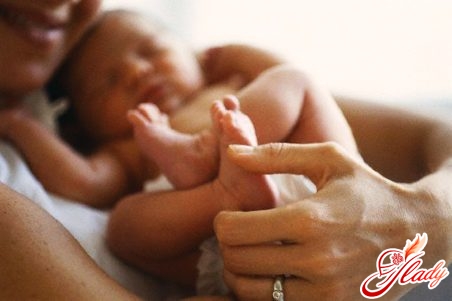 Difficulty with urinationurination is quite normal within the first 24 hours after delivery. Some women do not feel any pressure in the bladder, and some feel desperate, but can not empty the bladder. Some women urinate, but they feel pain and burning. The causes of bladder dysfunction in the postpartum period are many:
Difficulty with urinationurination is quite normal within the first 24 hours after delivery. Some women do not feel any pressure in the bladder, and some feel desperate, but can not empty the bladder. Some women urinate, but they feel pain and burning. The causes of bladder dysfunction in the postpartum period are many:
- the increase in the volume of the bladder is explained by the fact that after the birth the space for its expansion sharply increases; for this reason there is no need for frequent emptying;
- in the process of delivery, the bladder can be traumatized during the passage of the fetus. As a result, even a filled bladder may not signal the need for urinary diversion;
- anesthetics can reduce the sensitivity of the uterus to signals coming from the bladder;
- pain in the perineum can be the cause of spasmodic contraction of the urethra, which makes it difficult to remove urine. Swelling (swelling) of the perineum can also have an effect on urination;
- The bladder can be controlled by certainpsychological factors, for example, fear of pain, appearing with an empty bladder, unpleasant sensations when urinating, difficulties in using the boat, the need to use outside help in the toilet;
- increased sensitivity of joints applied toincision or rupture, may be the cause of pain when urinating (in this case, you can recommend standing up with your legs apart, while the urine stream directed downwards will not touch the painful sections of the urethra wall).
Despite the difficulties, it is necessary to emptybladder 6-8 hours after birth, in order to protect the urethra from a possible infection. If within 8 hours after giving birth alone you could not empty the bladder, you might be offered to use a catheter. You can help your body:
- as soon as possible after birth, get out of bed and walk around, it stimulates the work of both the bladder and the intestines;
- if you are too weak to go to the toilet yourself and are forced to use the ship, then ask (if possible) to recover without strangers;
- use the vessel while sitting, not lying down;
- try warming up the perineum with warm compresses or cooling with an ice-warmer, choose the way that stimulates urination.
In a day there may be another problem -excessive urination. As the hormones are removed from the body after pregnancy, urination becomes more frequent and abundant. If after several days later the urine output is still small or difficult, it is quite possible that this is the result of getting the infection into the urinary system. Inflammation of the bladder is accompanied by burning in the urethra, frequent and small in volume urination, a slight increase in temperature. Symptoms of kidney infection are more distinct - the temperature (up to 38-40 ° C), the pain in the lumbar region on both sides, usually accompanied by manifestations of inflammation of the bladder, can sharply rise. In this case, antibiotic treatment is necessary. After giving birth, many women notice that they can hardly hold urine, especially when sneezing, coughing, or laughing. This happens if, during childbirth, the constrictive muscle - the sphincter of the bladder - is excessively stretched. Such exercises help:
- squeeze the vagina and after 10 seconds, relax it; while the muscles of the walls of the vagina are strengthened;
- empty the full bladder not immediately, but gradually, alternating the release of small portions of urine with the compression of the vagina.
After regular exercise, the lock muscle will harden and hold urine.
Functioning of the intestine
As a rule, after delivery, the tone of the intestines is lowered,digestion is slow, the stool is absent. In order for the intestines to function normally after the birth, several physiological factors should interact: weakened after the birth of the abdominal muscles, possible damage to the intestine, and finally, psychological factors: unreasonable fear of divergence, natural anxiety due to lack of intimate conditions in the ward , as well as an excessive concentration of attention on what needs to be done. Restoring normal operation of the intestines will help to maintain a diet (cereal dishes, fresh vegetables and fruits); the use of fluid in a larger volume (water, juices), motor activity and stress relief. Sometimes puerperas swelling and inflamed hemorrhoids, in this case help the lotions of chamomile, warm and cold compresses, rectal suppositories, anesthetic gels and ointments, etc.
Troubling signs of the postpartum period
In the first 6 weeks after childbirth,postpartum complications. The following table describes some of the symptoms that you should contact the doctor for. A short-term rise in temperature (up to 38 ° C) with the appearance of milk (1-3 days) is not a cause for concern. 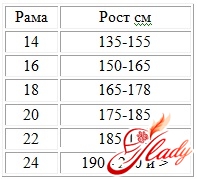
Restoration of motor activity
In the absence of contraindications (severe labor,cesarean section) no later than 24 hours need to get out of bed, some doctors allow you to get up after 8-10 hours. The faster you get up, the sooner you'll have an independent urination and stool, the function of the genitals will be restored, the abdominal wall will be tightened. In addition, it is a good prevention of thromboembolic complications. From the first day in the morning you can perform light physical exercises. Do them lying on your back and try not to overwork.
We advise you to read:




